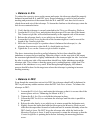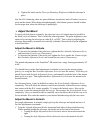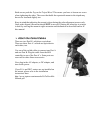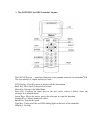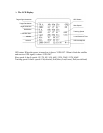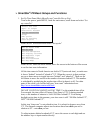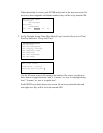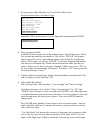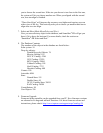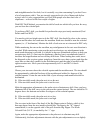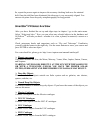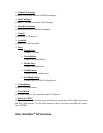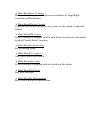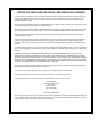and straightforward at first look, but it is actually very time consuming if you don’t have
a lot of experience with it. You are strongly suggested to do a lot of homework before
trying it out. It is also suggested that you work with people who have had a lot of
experience -- at least for the first couple of nights.
With DEC Drift Method, you monitor the drift of each star which tells you how far away
you are from the celestial pole.
To perform a DEC drift, you should first perform the steps previously mentioned (Find
Polaris and Find NCP).
You need to pick two bright stars to do the DEC drift. One should be close to the eastern
horizon and the other due south near the meridian. Both stars should be near the celestial
equator (i.e., 0° declination). Monitor the drift of each star one at a time and in DEC only.
While monitoring the star on the meridian, any misalignment in the east-west direction is
revealed. While monitoring a star near the east/west horizon, any misalignment in the
north-south direction is revealed. It is helpful to have an illuminated eyepiece to help you
recognize any drift. To fine tune the alignment, a Barlow lens is recommended since it
increases the magnification and reveals any drift faster. When looking due south, insert
the diagonal so the eyepiece points straight up. Insert the cross hair eyepiece and align the
cross hairs so that one is parallel to the declination axis and the other is parallel to the
right ascension axis. Move your telescope manually in R.A. and DEC to check
parallelism.
Choose your star near where the celestial equator and the meridian meet. The star should
be approximately within half an hour of the meridian and within five degrees of the
celestial equator. Center the star in the field of your telescope and monitor the drift in
declination.
If the star drifts south, the polar axis is too far east.
If the star drifts north, the polar axis is too far west.
Make the appropriate adjustments to the polar axis to eliminate any drift. Once you have
eliminated all of the drift, move to the star near the eastern horizon. The star should be 20
degrees above the horizon and within five degrees of the celestial equator.
If the star drifts south, the polar axis is too low.
If the star drifts north, the polar axis is too high.
The two stars in the front of the bowl of the Big Dipper point to Polaris, which is less
than one degree from the true (north) celestial pole. Cassiopeia, the “W” shaped
constellation, is on the opposite side of the pole from the Big Dipper. The North
Celestial Pole (N.C.P.) is marked by the “+” sign.
Again, make the appropriate adjustments to the polar axis to eliminate any drift.
Unfortunately, the latter adjustments interact with the prior adjustments ever so slightly.



